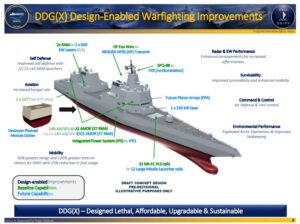The Chief of Naval Operations recently said the Navy will retain a lead on designing the next destroyer, DDG(X), and compared the effort to the transition from the Ticonderoga-class cruisers to the current
Arleigh Burke-class (DDG-51) destroyers.
As the Navy learns from moving forward with the Constellation-class guided-missile frigate, “I think it’s important that the Navy maintain the lead on design. And so what we’ve done with DDG(X) is we brought in the private shipbuilders, so that they can help inform the effort. So it’s a team, but it’s Navy led,” Adm. Mike Gilday said during a virtual Defense One event on Sept. 14.

Gilday noted both of the shipyards that build the current DDG-51s, HII’s Ingalls Shipbuilding [HII] in Pascagoula, Miss., and General Dynamics’ Bath Iron Works [GD] in Bath, Maine, are involved in the initial DDG(X) design process and the Navy intends to only start building the first ship once the design is mature.
“So what that would mean is more than the 80 percent complete point when we actually start bending metal,” he said.
Gilday argued the service has already seen success with the Columbia-class ballistic missile submarine program (SSBN), which reached over 80 percent design completion as the shipbuilder started building the first hull.
In June, General Dynamics’ Electric Boat held a keel laying ceremony for the first new SSBN, the future USS District of Columbia (SSBN-826). If ready on time, SSBN-826 is due to enter service in 2027 (Defense Daily, June 6).
The CNO said the Navy will pay close attention to DDG(X) design competition “because it actually drives down technical risk.”
He admitted “technical risk has been a challenge for us, whether it’s Zumwalt, [Littoral Combat Ship], or Ford. In particular, those three builds, we’ve accepted technical risks and it’s cost us in terms of keeping those ships not not only within budget, but also on schedule.”
The CNO also compared building this new hull design destroyer to the shift from the Aegis-capable guided-missile cruisers to destroyers.
“An example might be the shift from the Ticonderoga cruiser, to the Arleigh Burke destroyer, where [we] essentially used the same combat system, the same weapon system, but the hull is different. And so our intent toward DDG(X) would be much the same – that we’d use a proven combat system on that ship.”
Gilday reiterated the Navy wants a new ship design because “we need a ship that has more space and allows for more weight and for capability growth over time. An example might be hypersonic missiles where, just based on the size of those missiles, we couldn’t fit those in a current Arleigh Burke destroyer, even a Flight III. So it’s a deeper ship, if you will, from that standpoint, as well as leveraging technologies like electric drive.”